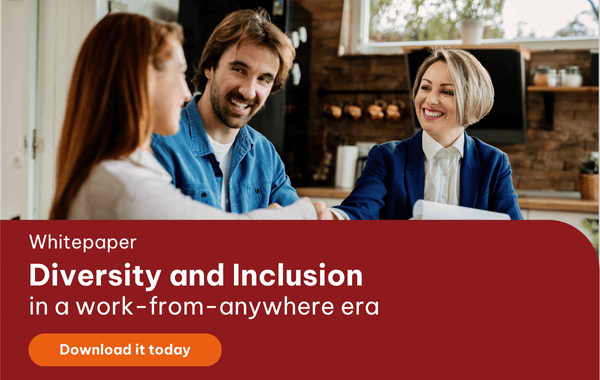Thanks to advancements in technology and the process of globalisation, people are now more interconnected than ever. As a result, workplaces are becoming increasingly diverse and inclusive, with individuals from various nationalities, cultures, genders, experiences, and personalities coming together under one roof. This transformative trend has compelled corporations to rethink how they manage their talent resources to leverage the benefits of multicultural perspectives.
Read more: More diversity and inclusion in the workplace challenges to discover

Content
- 5 common diversity and inclusion challenges in the workplace
- Overcoming diversity and inclusion challenges
5 common diversity and inclusion challenges in the workplace
Despite offering countless benefits, fostering diversity and inclusion in the workplace does come with a handful of challenges. Here are five common reasons why employers feel hesitant to embrace a multinational environment.
1. Communications barriers
It is undeniable that a diverse and inclusive workforce can lead to an increase in innovation, unique opinions and approaches to problem-solving. However, conflicts due to differences in perspectives also escalate at the same time.
Communication barriers are an obstacle that every international business faces. Even when people use the same language, for example, English, variations in colloquialisms and accents between American, British, and Australian English could potentially cause misunderstandings.
More important, a language can have many implications that only people from these regions can understand correctly. Moreover, some gestures could easily be considered an offence even without us realising it.
Read more: Other communication issues in a digital workplace
Therefore, there will be more conflicts than in a normal working environment since the employees need more time to understand and cooperate. Working in highly diverse organisations calls for strong interpersonal skills and cultural sensitivity—not something that can be taught at school.
2. Stereotypes and prejudice
Stereotypes targeting specific groups of individuals are inevitable. Rather than making an effort to communicate and understand one another, employees may employ these stereotypes as an excuse to avoid collaborating with their colleagues.
Even more concerning are the grudges individuals hold against certain cultures, religions, and races. This leads to isolation and fragmented teams, which can quickly escalate into disruptions during the knowledge transfer process among employees.
Read more: Measure, Track, Enhance Diversity and Inclusion with Technology
3. Less trust
People from minority groups could feel like they are treated unfairly compared to the major groups. Similarly, they might also think the manager is nicer towards people with the same background.
Consequently, these groups would barely raise their voice when encountering problems. For instance, employees from some Asian countries may not feel comfortable voicing their opinions, especially when they are new to the job or are in junior roles.
This situation requires a sensible manager with solid leadership, EQ, and communication skills to manage a diverse team, make every member feel included, and align the team’s decisions with the business goals.
4. Visa requirements and cost of accommodation
As companies strive to build a diverse and inclusive workforce, they must navigate the complex and costly process of creating a global workforce. This involves establishing guidelines for working visa arrangements and employment policies that comply with local labour and immigration laws.
In some cases, organisations may sponsor the transfer of individuals to different locations. However, this sponsorship comes with loads of administrative work and a dedicated budget for accommodations and travel expenses.
5. Productivity
Cultural clashes can be detrimental to both productivity and employee morale. While diverse teams can potentially drive long-term success for businesses, unresolved conflicts arising from these clashes can have lasting negative effects on employee satisfaction, the company's reputation, image, and more.
It is crucial to effectively address and resolve these conflicts to foster a harmonious and inclusive work environment.
Read more: Emotional intelligence for leaders
Although it is not easy to manage a multicultural environment efficiently, there are plausible reasons to enhance the diversity rate of the business.
Why should organisations focus more on developing middle managers? Learn how you can strengthen this vital link in this whitepaper.
Overcoming diversity and inclusion challenges
Diversity and inclusion are crucial elements of sustainable business development, and it is a transformative movement that every company should embrace.
However, it could quickly become painful if the issues mentioned above are not addressed appropriately. Here are some suggestions that your company might want to follow for an equitable and inclusive working environment.
Focus on “culture add” not “culture fit”
The company should embrace the unique experiences and cultures of each employee. Different perspectives bring fresh ideas to combat the boring “sameness.” Companies should make an effort to understand the value of differences and continuously raise employees' awareness of the subject.
Managers and team leaders should provide their members with fair and open opportunities to share and contribute their approaches for improvement. Every employee needs to feel heard and respected for who they are and their capabilities. These unique experiences are invaluable for teams to build fertile ground for innovation.
Read more: Fostering diversity and inclusion through internship programs at TRG
All cultures deserve to receive the same appreciation and celebration. Make an effort to make it clear that you are willing to learn to understand other members' backgrounds. Therefore, everyone should have a chance to bring to the table their insights instead of modifying themselves to fit in with the majority. Treating your employees as unique individuals, not as a group of people, would help you overcome communication barriers.
Take a stance
Taking a neutral stance is no longer advisable as it can do more harm than good, leaving employees feeling that the company lacks conviction and fairness.
Read more: Ensuring fairness in your performance management
In today's interconnected world, it is essential for managers to stay informed about global events and take a proactive stance. This includes being aware of ongoing social issues such as the Black Lives Matter movement, gender inequality, and LGBTQI+ rights. By understanding and addressing these issues, managers can create a more inclusive and supportive work environment for all employees.
More than that, HR managers should play an active role in identifying and resolving any conscious and unconscious bias towards minority groups as fast as possible. Everyone, including you and me, wants to feel safe and supported by the companies they are working for.
Make better use of diversity
According to a Glassdoor survey, two-thirds of workers indicated that diversity is important when evaluating companies and job offers. In other words, showing proof that businesses are cultivating a diverse and inclusive culture would help them to stand out more in the competitive job market.
In a diverse workplace, each person has unique strengths and skills that others can learn from. Everyone should be given a chance to grow and learn, especially when exposed to unfamiliar cultures, working styles, and perspectives.
What’s more important is how organisations can incorporate collaboration projects and align employee development plans with the company’s objectives to ensure sustainability. Thus, the next crucial step is having an action plan to implement all the above ideas.
Looking to enhance your talent management processes in today's highly diverse and inclusive world? Connect with our TRG Talent team to explore how our range of psychometric assessments and 360-degree feedback surveys can empower you to attract, engage, nurture, retain, and identify top performers. Request a demo today and unlock the potential of your workforce!
 English
English  Vietnamese
Vietnamese 



